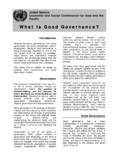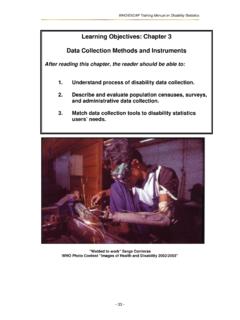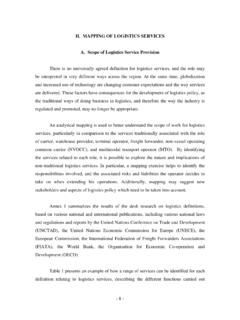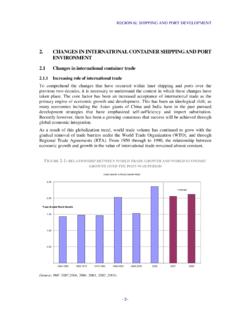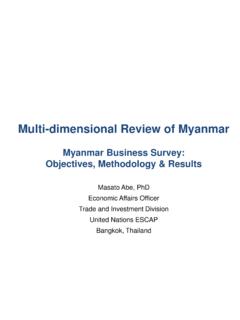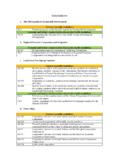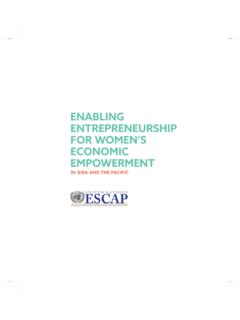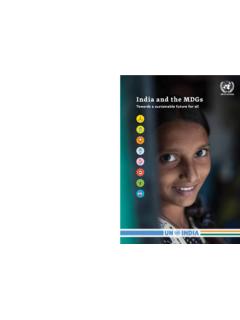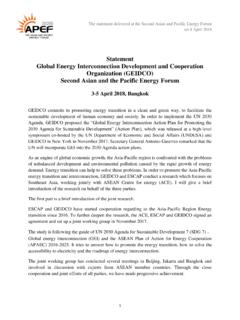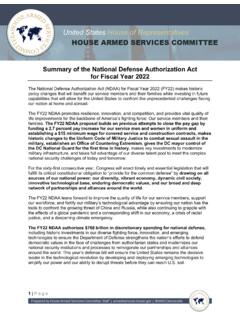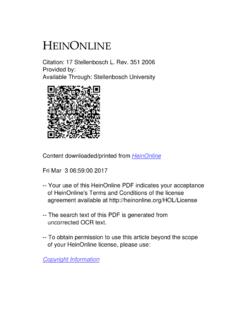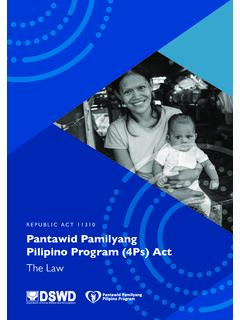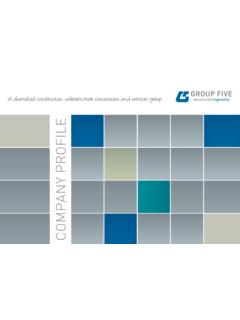Transcription of Poverty and Inequality Reducing Programs: Lessons from the ...
1 21/11/20171 Poverty and Inequality Reducing Programs: Lessons from the PhilippinesCelia M. ReyesSenior Research Fellow, PIDSS trategic Dialogue on Poverty and Inequality in Asia and the PacificUN ESCAP Bangkok, October 5-6, 2017 Philippine Institute for Development StudiesSuriansamgaPag-aaralPangkaunlaran ng PilipinasPoverty and Inequality Reducing Programs1. 4Ps Conditional Cash Tranfer to reduce inequalities in opportunities in education and reduce intergenerational Poverty 2. Community Based Monitoring System (CBMS) as a tool to reduce Poverty and Inequality at the local level21/11/20172 The Philippines Conditional Cash Transfer Program: PantawidPamilyangPilipino Program (4Ps)Philippine Institute for Development StudiesSuriansamgaPag-aaralPangkaunlaran ng PilipinasProgram Description To promote investment in human capital that ensures children belonging to poor households, aged 0-18, grow up healthy and stay in school Utilizes the conditional cash transfer scheme wherein beneficiaries receive cash grants based on their compliance to their co-responsibilities21/11/20173 Philippine Institute for Development StudiesSuriansamgaPag-aaralPangkaunlaran ng PilipinasAnnual budget of 4Ps Program, in million PhP, 2008-2017 Budget category/Year 2008 2009 2010 2011 2012 2013 2014 2015 2016 2017 Total1,297 8,300 10,000 21,194 39,445 44,911 62,614 62,323 62,666 78,187 Cash Grant299 5,000 10,000 17,138 35,447 40,417 57,575 56,140 56,025 72,115 Training- - - 1,625 703 507 219 219 219 158 Salaries- - - 716 1,877 2,375 3,351 3,351 3,410 3,817 Cost of Services- - - - - - 261 1,078 1.
2 187 821 Bank Service Fees - - - 171 346 426 550 700 782 695 Advocacy- - - 333 252 94 40 60 60 33 Capital Outlay- - - 218 133 0 80 24 0 0 Monitoring & Evaluation - - - 677 686 67 216 429 434 243 Administrative Expense - - - - - 370 322 322 549 305 Note: -no available detailsSource: Department of Social Welfare and Development (DSWD)Philippine Institute for Development StudiesSuriansamgaPag-aaralPangkaunlaran ng PilipinasEligibility Household is poor based on the Listahanan(formerly known as the National Household Targeting System for Poverty Reduction) Must have children aged 0-18 or have a pregnant member at the time of the enumeration. The program expanded the age coverage of eligible children beneficiaries from 0-14 to 0-18 years old to ensure that school-aged children will be given financial assistance until they reach 18 years old or finish high school, whichever comes first. Must be willing and able to comply with the conditionalitiesof the program as part of their Institute for Development StudiesSuriansamgaPag-aaralPangkaunlaran ng PilipinasProgram Features/Design Health Grant: P500 per month Education Grant Elementary -P300 per month for 10 months High School P500 per month for 10 months Maximum of three (3) children per household is covered by the program Children beneficiaries are covered until they exceed the age 18 or finish high school, whichever comes first.
3 Accordingly, the household will exit from the program when all the children beneficiaries graduate from high school or reach the maximum age of Institute for Development StudiesSuriansamgaPag-aaralPangkaunlaran ng PilipinasConditionalitiesFOR EDUCATION Children 6-18 years old enroll in primary/secondary schools or equivalent Alternative Learning System/Alternative Delivery Method, and have at least 85% school attendance Children 3-5 years old attend daycare/preschool program with at least 85% school attendance High school students are required to obtain a passing General Weighted Average (GWA) prescribed by the DepEd. High school students must also be promoted to the next grade level in the succeeding school Institute for Development StudiesSuriansamgaPag-aaralPangkaunlaran ng PilipinasConditionalities(cont d.)FOR HEALTH Children 0-5 years old get regular preventive health check-ups, growth monitoring and vaccines Pregnant women get pre- natal care and attended by skilled/professional health worker during child birth.
4 Mothers who have given birth get post- natal care in accordance with the standard DOH protocol Children 6-14 years old must receive deworming pills twice a yearPhilippine Institute for Development StudiesSuriansamgaPag-aaralPangkaunlaran ng PilipinasConditionalities(cont d.)FOR FAMILY DEVELOPMENT SESSION Eligible households will have to attend the Community Assembly (ComAss) for their actual registration for the program. Households are required to submit documentary requirements such as marriage certificate and birth certificates of the children21/11/20176 Philippine Institute for Development StudiesSuriansamgaPag-aaralPangkaunlaran ng PilipinasNumber of Beneficiary Householdsin data: DSWDP hilippine Institute for Development StudiesSuriansamgaPag-aaralPangkaunlaran ng PilipinasFindings: Impact Evaluations 1 & 2 Increased school enrolment, school attendance, and access to key maternal and child health care services. The program keeps children in school. The program also increases households investment in education.
5 It keeps poor children healthy; reduced severe stunting. Reduced hours of child labor among poor Institute for Development StudiesSuriansamgaPag-aaralPangkaunlaran ng PilipinasFindings: Impact Evaluations 1 & 2 The program also encouraged poor mothers to avail maternal health care services and the poor children to take up Vitamin A, deworming pills, and regular weight monitoring. More Pantawid mothers delivered in health facilities and accessed postnatal care services by skilled health professionals. The program has not affected decisions to work and fertility Institute for Development StudiesSuriansamgaPag-aaralPangkaunlaran ng PilipinasProportion of children attending school has been increasing over to 1112 to 1516 to 18 Proportion of children attending school, by age group and by year, 2014 (in %)Source of basic data: Philippine Statistics Authority, Annual Poverty Income Survey21/11/20178 Philippine Institute for Development StudiesSuriansamgaPag-aaralPangkaunlaran ng PilipinasProportion of children attending school increases with to 1112 to 1516 to 18 Proportion of children attending school, by age group and by income decile, 2014 (in %)Source of basic data.
6 Philippine Statistics Authority, Annual Poverty Income SurveyPhilippine Institute for Development StudiesSuriansamgaPag-aaralPangkaunlaran ng PilipinasMore than half of those who have been in the program for at least 5 years are still poorMagnitude of poor families and Poverty incidence by year of entry in 4 PsYear of entryMagnitude of poor families who are 4Ps beneficiariesPoverty incidence (%)2009504, , , , , , , ,944, : PIDS ESD- Poverty Team estimates using FIES2015, PSA21/11/20179 Philippine Institute for Development StudiesSuriansamgaPag-aaralPangkaunlaran ng PilipinasLessons Moving people out of Poverty requires a package of interventions Results suggest reduction in Poverty but it is too early to say if it reduces intergenerational Poverty . Outstanding issue is the exit or graduation policy. Requires a significant amount of resources to sustain the program, for both direct program costs as well as administrative costs of targeted programsCommunity Based Monitoring System (CBMS)21/11/201710 BACKGROUND ON CBMSN ational /RegionalProvincialMunicipal/CityVillage /BarangayAdministrative StructureInformation AvailabilityCBMS can fill the gapNational surveysCBMSR esource constraints and distributive objectives increase the demand for local data that can support targeting schemesPhilippine Institute for Development StudiesSuriansamgaPag-aaralPangkaunlaran ng PilipinasLocalizing the SDGs Leaving no one behind requires data on the different dimensions of Poverty for the same household at the same time21/11/201711 Philippine Institute for Development StudiesSuriansamgaPag-aaralPangkaunlaran ng PilipinasKEY FEATURES OF CBMS It is an organized way of collecting household and individual level data with the following features.
7 Designed primarily to provide inputs for local level planning and budgeting; lodged at the planning units of local government units Census of all households in the community Uses mobile-based technology to collect data and GIS to present spatial disparities Conducted periodically Provides data on the different dimensions of Poverty , including the multidimensional Poverty index (MPI) Can provide data for 32 out of the 232 SDG indicators, including the desired disaggregations ( Leaving no one behind ) CBMS aims to Promote transparency and accountability Support rational allocation or resources Empower the communityBACKGROUND ON CBMSN ational /RegionalProvincialMunicipal/CityVillage /BarangayAdministrative StructureInformation AvailabilityCBMS can fill the gapNational surveysCBMSR esource constraints and distributive objectives increase the demand for local data that can support targeting schemes21/11/201712 Philippine Institute for Development StudiesSuriansamgaPag-aaralPangkaunlaran ng PilipinasCBMS Responds to.
8 Lack of necessary disaggregated data for: Diagnosingextent of Poverty at the local level Determiningthe causes of Poverty Formulatingappropriate policies and program Identifying eligible beneficiaries Assessingimpact of policies and programs Need for support mechanisms for the implementation of the decentralization policy CBMS facilitates greater transparency and accountability in local governancePhilippine Institute for Development StudiesSuriansamgaPag-aaralPangkaunlaran ng PilipinasTargeting of Interventions CBMS can identify who and where the poor are and what are their needs CBMS directs assistance to those who need it most21/11/201713 Philippine Institute for Development StudiesSuriansamgaPag-aaralPangkaunlaran ng PilipinasCBMS Core Indicators of PovertyDimensionIndicatorHealth and NutritionProportion of children under 5 who diedHealth poorProportion of women who died due to pregnancy related causesProportion of children aged 0-5 who are malnourished Nutrition poorHousingProportion of households in
9 Makeshift housingHousing poorProportion of households who are informal settlers Tenure poorWater and SanitationProportion of households without access to safe water supplyWater poorProportion of households without access to sanitary toilet facilitiesToilet poorPhilippine Institute for Development StudiesSuriansamgaPag-aaralPangkaunlaran ng PilipinasDimensionIndicatorEducationProp ortion of children 5 years old who are not attending kindergartenEducation poorProportion of children 6-11 years old who are not attending elementary school Proportion of children 12-15 years old who are not attending secondary (junior high) schoolProportion of children 16-17 years old who are not attending senior high schoolProportion of children 6-15 (5-17) years old who are not attending schoolCBMS Core Indicators of Poverty21/11/201714 Philippine Institute for Development StudiesSuriansamgaPag-aaralPangkaunlaran ng PilipinasCBMS Core Indicators of PovertyDimensionIndicatorIncome and HungerProportion of households with income below the Poverty thresholdIncome poorProportion of households with income below the food thresholdIncome poor(extreme)Proportion of households who experienced hungerdue to food shortageEmploymentProportion of persons in the laborforce who are unemployedJob PoorPeace and OrderProportion of persons who are victims of crimeSecurityPoorPhilippine Institute for Development StudiesSuriansamgaPag-aaralPangkaunlaran ng PilipinasCBMS and the SDGs SDGs focus on disaggregation by sex, age, geographic area, ethnic groups, etc.
10 CBMS collects data on each and every member of the household, covers all the households and collects data on the different dimensions of Poverty . Thus, CBMS data can be used to estimate some of the SDG indicators, including Multidimensional Poverty Index (MPI), and the desired disaggregation for these Institute for Development StudiesSuriansamgaPag-aaralPangkaunlaran ng PilipinasCBMS and the SDGs32 SDG indicators can be generated using the CBMS dataGoalSDG Indicators that can be generated using CBMS1721354651627184101114132164171 Total39 Philippine Institute for Development StudiesSuriansamgaPag-aaralPangkaunlaran ng PilipinasSource: CBMS Census in the City of Panabo, 2009 and 1 Goal 2 Goal 3 Goal 4 Goal 5 Goal 7 Goal 8 Goal 10 Goal 11 Goal 16 Goal 1720092016 GoalIndicator20092016 Goal Proportion of population below the international Poverty line, by sex, age, employment status and geographical location (urban/rural) ; using Prevalence of malnutrition (weight for height >+2 or <-2 standard deviation from the median of the WHO Child Growth Standards) among children under 5 years of age, by type (wasting and overweight) Under-five mortality rate, per (a) Net enrolment rate in primary education Proportion of individuals who own a mobile telephone, by sex (proxy.)
